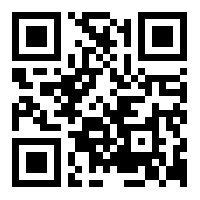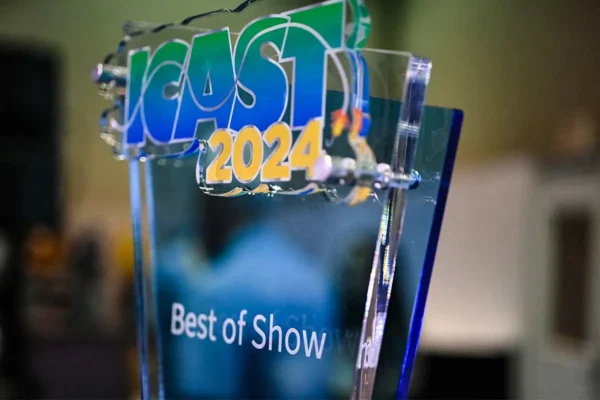If you’re on a quest to engage attendees, QR codes can help.
A darling of the ad industry, the Quick Response (QR) code was invented 20 years ago by a Japanese automotive engineer who wanted a way to inventory car parts. The spidery squares are a kind of bar code that’s intelligible to the digital image processors packed inside our smartphones.
a Japanese automotive engineer who wanted a way to inventory car parts. The spidery squares are a kind of bar code that’s intelligible to the digital image processors packed inside our smartphones.
The small dots within a QR code represent a series of letters and numbers – typically a URL.
When you scan – or, more properly, “snap” – a QR code, your phone unscrambles the dots and automatically directs your Web browser to the URL and … Voila, instant Webpage.
For good reason, techies call the act of snapping a QR code “hard-linking.”
QR codes are a boon to exhibitors who are sick of schlepping tons of collateral – or the wrong collateral – to tradeshows, according to Kristin Veach, senior vice president of marketing and business development, Live Marketing.
“It’s hard for an exhibitor to have readily available all the information attendees want,” said Veach. “One of the big benefits that QR codes offer exhibitors is the ability to provide attendees whatever they want, when they want it. If an attendee is in your booth and wants to see a particular video, white paper or product sheet, a QR code can be a great way to provide it.”
A QR code can also offer a great way to give attendees the schedule of events planned by your company. A QR code can inform them of in-booth demos, executive briefings, news conferences, after-parties and raffles. And your raffles themselves can be revved up through the smart use of a QR code.
“A QR code can be a great way to allow attendees to enter a grand prize drawing,” said Veach. “It can also be a fun way for people to get prizes. By snapping a QR code, they can learn what they’ve won.”
Because QR codes can deliver any digital asset, the sky’s the limit when it comes to how you can use them in your booth. Let creativity be your guide.
“QR codes can be placed on sales literature, signage, tattoos and T-shirts,” said Veach. In fact, exhibitors should accustom themselves to carrying to every tradeshow a “virtual backpack.” That way, they’re always prepared to provide attendees any digital asset of which they might think.
When used well, QR codes also promote deeper attendee engagement.
One of Veach’s exhibitor-clients displayed a QR code on a charging station – nick-named a “juice bar” – where attendees could recharge their mobile phones free of charge. While they stood around waiting, they could answer an online survey that was hard-linked from the QR code. Attendees who completed the survey were entered into a prize-drawing for a Kindle Fire.
The QR code was a hit.
“Attendees’ adoption of QR codes is growing quickly, and the list of cool opportunities goes on and on,” said Veach.
But that doesn’t mean QR codes should be used indiscriminately.
“Don’t be so creative that it defeats the purpose of the QR code,” said Veach. “For example, don’t put one on the side of a bus or on a highway billboard. That’s not going to pan out. And don’t put QR codes on Websites. That doesn’t make any sense, either.”
When creating QR codes, it is important to consider your audience.
“Like with everything else, think about your target audience and ask if QR codes are a good fit,” said Veach. “Are your attendees tech-savvy? Will they carry mobile phones that can scan QR codes? If not, then there’s no sense in creating a QR code program for them. But if they’re an audience of technicians who typically have smartphones, that’s a good match.”
You must also remember that, even for tech-savvy tradeshow-goers, QR codes are relatively novel.
“Not everyone knows yet how to use QR codes,” said Veach. “So consider providing your attendees with instructions about what to do, how to download a QR code reader and how to scan a QR code. The more clearly you can tell attendees what to do, the higher your adoption rate will be.”
An in-booth Sherpa wouldn’t hurt either.
“Consider having an ‘experience-enabler,’ like you would with other technologies,” said Veach. “A live person ready to help attendees facilitate the QR code experience will eliminate user problems and issues.”
It’s also imperative to remember the context in which attendees are hard-linking through your QR codes.
“It’s particularly important for exhibitors to think about the relevance of the information delivered to the attendee by the QR code,” said Veach. “If someone is standing at a demonstration station in your booth and snaps a QR code, it’s most likely they want detailed product information. Don’t be giving them something that isn’t contextual, because it will potentially turn them off. Similarly, if you’re asking attendees to snap a QR code to enter a prize drawing, make sure they are taken to an entry form and not some other Webpage.”
Captions are as equally important as context.
“Clearly identify what attendees should expect to get by scanning your QR code,” said Veach. “Don’t just display a QR code without any caption or a call to action, because attendees need to know what’s in it for them. If you want attendees to enter your grand prize drawing by snapping your QR code, promote that fact. If you do, they’re much more likely to participate.”
Lastly, be sure the Webpages you direct attendees to are mobile-friendly.
“Always keep in mind that you’re asking attendees to link to a Webpage through a mobile phone,” said Veach. “If the copy on that Webpage is too long or difficult to read, you’re going to turn them off.
# # #
Bob James is vice president of marketing for ITN, an event-analytics company known for pioneering the use of NFC (short-range wireless) within the exhibitions industry. With operations in China, France, New Zealand, the U.K. and the U.S., ITN provides exhibitors – more than 150,000 of them – with innovative lead-management solutions based on NFC.





























